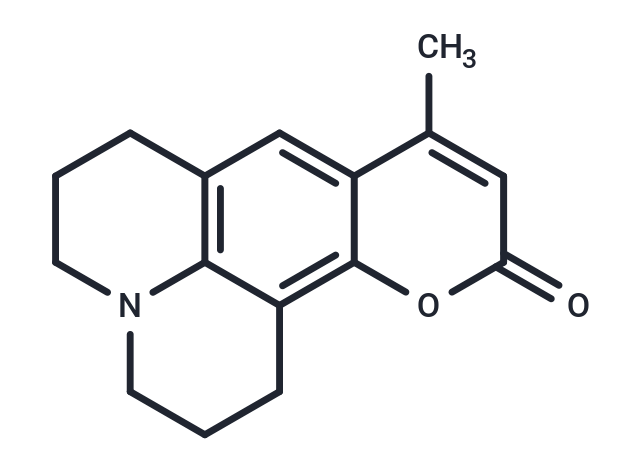
Coumarin102
CAS No. 41267-76-9
Coumarin102( —— )
Catalog No. M36953 CAS No. 41267-76-9
Coumarin102 (Exciton 480) is a fluorescent dye.Coumarin102 has weak inhibitory activity against Monoamine oxidase B, MAO-B and MAO-A and can be used to study neurological disorders.
Purity : >98% (HPLC)
 COA
COA
 Datasheet
Datasheet
 HNMR
HNMR
 HPLC
HPLC
 MSDS
MSDS
 Handing Instructions
Handing Instructions
| Size | Price / USD | Stock | Quantity |
| 50MG | 46 | Get Quote |


|
| 100MG | 56 | Get Quote |


|
| 500MG | 131 | Get Quote |


|
| 1G | Get Quote | Get Quote |


|
Biological Information
-
Product NameCoumarin102
-
NoteResearch use only, not for human use.
-
Brief DescriptionCoumarin102 (Exciton 480) is a fluorescent dye.Coumarin102 has weak inhibitory activity against Monoamine oxidase B, MAO-B and MAO-A and can be used to study neurological disorders.
-
DescriptionCoumarin 480 (Coumarin 102) is a laser dye.
-
In Vitro——
-
In Vivo——
-
Synonyms——
-
PathwayMembrane Transporter/Ion Channel
-
TargetMonoamine Transporter
-
RecptorMonoamine Oxidase | MAO
-
Research Area——
-
Indication——
Chemical Information
-
CAS Number41267-76-9
-
Formula Weight255.31
-
Molecular FormulaC16H17NO2
-
Purity>98% (HPLC)
-
Solubility——
-
SMILESCc1cc(=O)oc2c3CCCN4CCCc(cc12)c34
-
Chemical Name——
Shipping & Storage Information
-
Storage(-20℃)
-
ShippingWith Ice Pack
-
Stability≥ 2 years
Reference
1. Shivaraj A. Patil, et al. Evaluation of ground and excited state dipole moments of coumarin 480 in aqueous DMSO: An experimental and DFT/TDDFT study.
molnova catalog



related products
-
Lenumlostat
Lenumlostat is an orally available, selective and potent lysyl oxidase-like protein 2 (LOXL2) inhibitor with inhibitory effects on hLOXL2, hLOXL3 and LOXL2 for the study of fibrotic diseases.
-
(+)-Tetrabenazine
(+)-Tetrabenazine ((3R,11bR)-Tetrabenazine) is a reversible vesicular monoamine transporter 2 (VMAT-2) inhibitor, inhibits transport by VMAT2 with 10-fold greater potency than transport by VMAT1.
-
Paroxetine hydrochlo...
An antidepressant of the selective serotonin reuptake inhibitor (SSRI) class.



 Cart
Cart
 sales@molnova.com
sales@molnova.com


